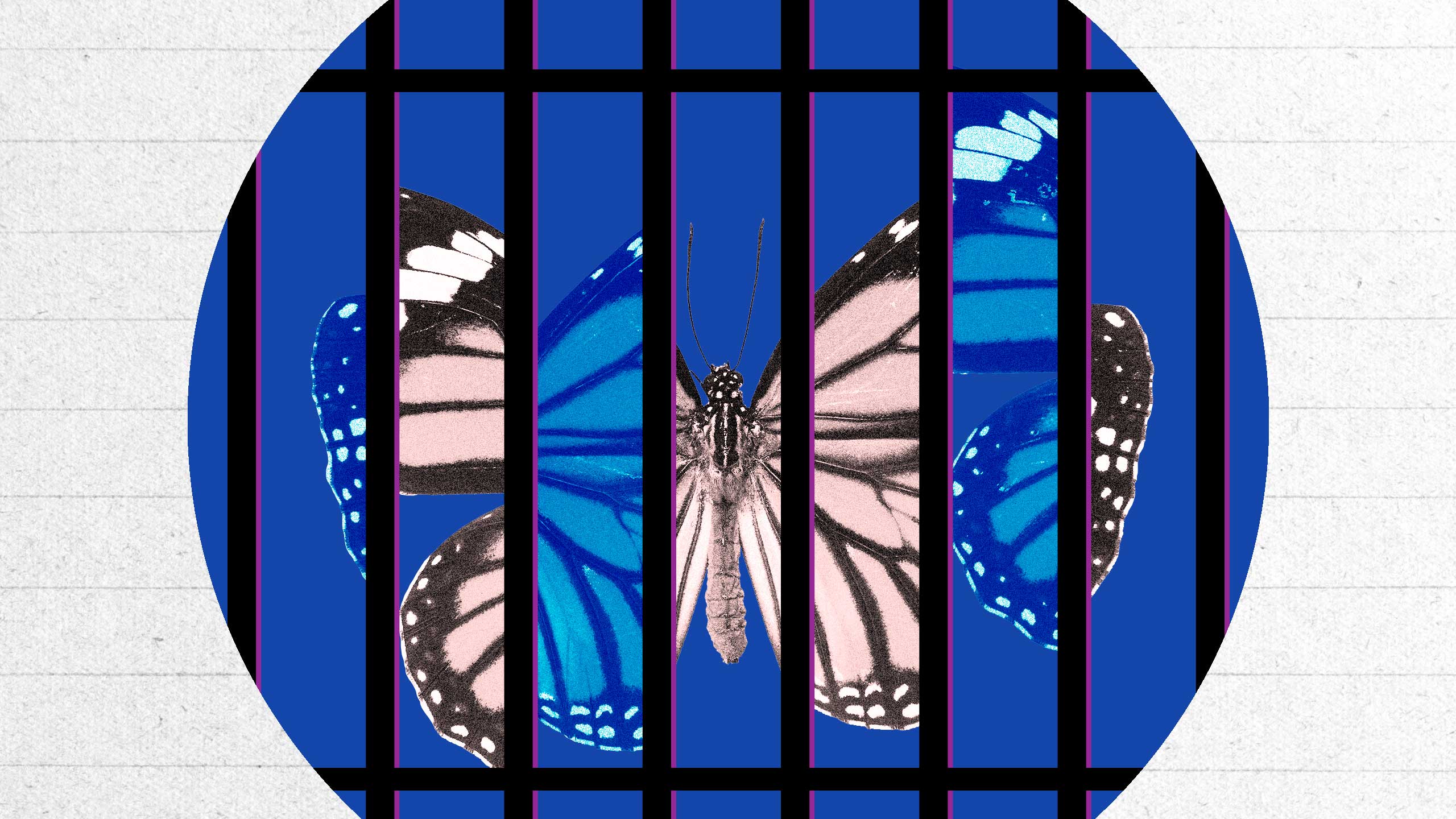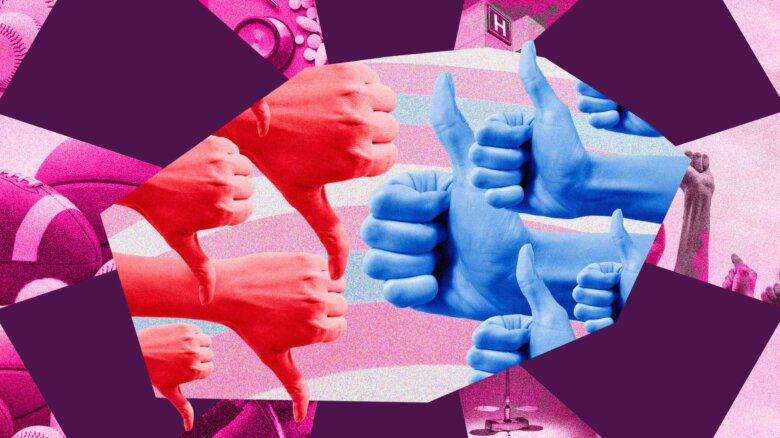Content warning: This story discusses phyiscal and sexual violence against trans people and suicide.
In 1989, 27-year-old Synthia Kavanagh, a trans woman, was convicted of second-degree murder and sent to Millhaven Institution, a men’s maximum-security prison in Bath, Ontario, some two hours east of Toronto. There, doctors discontinued the hormone therapy she had been undergoing since she was 13 years old. Years later, she would describe to the Canadian Human Rights Tribunal the “pain” and “panic” she felt as she watched her body slowly revert to physical and sexual characteristics she had escaped through great effort and hardship. Her anguish was likely compounded by the emotional turmoil that happens when the hormones that had been introduced into her body—likened to a second puberty, with all the attendant feelings of that metamorphosis—were suddenly reversed.
At the time Correctional Service Canada (CSC) officially prohibited people from transitioning from one gender to another while incarcerated, so Kavanagh’s experience wasn’t unique. Deprived of hormones, trans prisoners often felt existential despair, and they rarely had the support they needed to manage the enormity of those feelings. Some attacked their own bodies. Some attempted suicide.
Katherine Johnson, another trans woman incarcerated in a men’s prison during that period, tried to take her life on multiple occasions because the institution didn’t acknowledge her gender identity or take seriously her pleas for gender-affirming surgery. She tried to cut off her penis twice. Once, she successfully castrated herself, walked down the range using a folded towel to staunch the blood pooling between her legs and flushed both testicles down the toilet.
In her autobiography Prisoner of Gender, Johnson describes how men beat her because she was trans, and, aware that she had little recourse to official protection from the prison system, they frequently raped her. When she’d find strongmen to protect her, they too would be attacked. A man named Cliff served as her guardian for a time, but he was beaten by several men who wanted access to Johnson’s body; his head was cracked open by a metal bar, and his face was mutilated by multiple stab wounds. When another man offered to look after her, he was speared in the back with a sharpened steel rod while crouched, tying his shoelaces. I’ve written extensively about prisoners’ autobiographies, and Johnson’s depictions of her victimization in Canadian prisons are some of the most troubling accounts of violence I’ve read.
Trans people’s lives have been marked by unrepentant brutality in Canadian prisons. Trans men also struggle to live in a criminal justice system that has refused to acknowledge them according to their gender identity. (Boyd Kodak, for instance, was forced into women’s clothing when he was imprisoned in 2012.) Fearing violence and harassment if they were to be placed in men’s prisons, many trans men choose not to disclose their identities to officials after their incarceration and serve their time in women’s facilities. These trans men are often forced into an impossible choice: either live in an institution that reinforces their misgendering or live in an institution where their lives are at risk. Perhaps because trans women are compelled to live in the gladiatorial world of men’s prisons and so experience more frequent and direct violence, they have played a more visible role in the fight for trans rights behind bars.
“It’s a story about trans people fighting for their rights in some of the most dehumanizing places in the world.”
Data about trans people in federal custody is hard to obtain, including statistics about how many trans people are incarcerated. That’s a feature of a secretive federal agency that is aggressively resistant to oversight or outsider intervention. But an unpublished report from 2016 archived at the Canadian Human Rights Commission (CHRC) notes that the commission has seen complaints from trans prisoners double over a decade and a half, reflecting the violence experienced by trans people behind bars.
Recent years have seen changes to Canadian laws around gender identity and expression, and those laws have shifted the legal and cultural landscape of Canadian prisons, transforming the lives of prisoners like Kavanagh and Johnson. But how trans prisoners’ rights have changed—and what laws and policies still need changing—is a story that has profound consequences for Canadians. It’s a controversial story about the disruption of our legal understanding of gender and sex, and about contentious reforms to our criminal justice system. It’s also a recent story—one that’s still unfolding in our prisons and policies and laws. Most importantly, it’s a story about trans people fighting for their rights in some of the most dehumanizing places in the world.
In the late 1980s and early ’90s, trans prisoners like Johnson and Kavanagh feared for their lives. They could never rely on the institution for protection, even though it was mandated to be their guardian. Like Johnson, Kavanagh was routinely pursued and harassed for sex by members of the all-male prison population. She became a catalyst for violent conflict, and she was frequently beaten and raped. So, in 1993, Kavanagh fought back.
She brought three human rights complaints against CSC (Kavanagh v. Canada). With the support of her lawyer, barbara findlay, Kavanagh argued that CSC’s decisions to place her in a men’s institution, halt her hormone treatment and ban her from receiving gender-affirming surgery were discriminatory.
Two kinds of discrimination were the basis for her case: sex and disability. Kavanagh claimed that CSC’s decisions constituted discrimination on the basis of disability because she had been diagnosed with Gender Identity Disorder (GID). First defined in the Diagnostic and Statistical Manual of Mental Disorders, Fourth Edition, GID was a term that denoted a feeling of incongruence between one’s birth sex and the gender with which one identified, and a consistent discomfort, or “dysphoria,” that accompanied those feelings.
The disability argument illuminates a conundrum for trans prisoners like Kavanagh in a highly conservative system like CSC. For the prison to recognize them according to their gender, trans people first needed to have their identities authenticated by the psychomedical establishment, by doctors or psychiatrists—a powerful system that was crucial to trans self-determination through medical or surgical intervention but that had also pathologized transness and categorized trans people as abnormal, sick or mentally ill.
At the time, trans people who wanted to access medical services in support of their transition, like hormones or surgery, or even to access government documentation to support their gender identity, needed a GID diagnosis. To receive this diagnosis, they had to meet a set of criteria called the “Harry Benjamin Standard of Care,” established by the Harry Benjamin International Gender Dysphoria Association in 1979. These criteria included living as a trans person in the community for at least a year (called “the real-life experience”), receiving a full year of continuous hormone therapy and undergoing a psychological evaluation.
“The Kavanagh decision was something of a double-edged sword for trans people, especially trans women.”
For Kavanagh, the GID diagnosis was a necessary precondition for her to access the care she needed while incarcerated, including gender-affirming surgery. But the Standard of Care criteria was a problem: during the Canadian Human Rights Tribunal hearings, some specialists argued that “real-life experience” could not be met in prison since prison was not like real life. An expert on gender identity who regularly consulted with CSC argued that the “facultative homosexuality” of the prison environment—what some prisoners objectionably call being “gay for the stay”—meant that trans people were more accepted within the prison than they were on the outside, an argument that disregards the high levels of violence experienced by trans prisoners. Trans people, the expert suggested, could encounter hostility upon their release and regret their decision to transition during incarceration, which could be quite damaging. And it could result in litigation for CSC.
Ultimately, despite this concern and other objections, the Tribunal concluded that CSC’s denial of Kavanagh’s hormone therapy and gender-affirming surgery, and its refusal to allow Kavanagh to serve her time in a women’s institution, was discriminatory on the basis of sex and disability. Kavanagh v. Canada made it possible for some trans people to undergo hormone therapy and gender-affirming surgery while incarcerated, and it made it more likely that a trans person could serve time in the institution that best suited their gender identity (although the process was hardly straightforward or easily accessible). In 2008, with the legal guidance of Jennifer Metcalfe at Prisoners’ Legal Services (PLS), Katherine Johnson used the Kavanagh decision as a precedent in a human rights complaint against CSC that ultimately allowed Johnson to have gender-affirming surgery and transfer to a women’s prison, Fraser Valley Institution, where she remained until her death in 2014.
And yet, the Kavanagh decision was something of a double-edged sword for trans people, especially trans women. The Tribunal concluded—and counsel for CSC conceded—that the prison system’s policy that pre-operative trans people be held in prisons that accorded with their birth sex rather than their gender identity was prima facie discriminatory. Nevertheless, the Tribunal decided that trans women who don’t undergo gender-affirming surgeries shouldn’t serve time in women’s prisons because, wrote the Tribunal in their decision, “pre-operative male to female transsexuals pose a potential risk to female inmates.”
The Tribunal noted that a majority of imprisoned women had experienced abuse, including sexual abuse, perpetrated by men. They worried that having what it called “an anatomically male inmate” in a female prison population could be dangerous. Or, at the very least, they could frighten women who had experienced sexual violence at the hands of men outside prison. “Like transsexuals,” the Tribunal wrote in their decision, “female inmates are a vulnerable group, who are entitled to have their needs recognized and respected.”
The Tribunal’s thinking was entangled with a damaging myth. In discussing trans women who have not undergone gender-affirming surgeries, they use the aforementioned term “anatomically male inmate,” then shifts to discussing men. Of course, in their decision, they are not addressing men but trans women. And so, quite subtly, the Tribunal represents trans women not as women but as men passing as women. Representing trans women as disguised men fits a narrative that circulates widely outside prisons—a story about trans people that justifies their exclusion from the social sphere, from gendered spaces like bathrooms and locker rooms: a story that authorizes violence against trans people who dare overstep gendered boundaries by behaving as though their chosen identities are normal. It’s an anti-trans story about a wolf-in-sheep’s clothing.
“Crimes that give credence to the wolf-in-sheep’s-clothing story are attributed to trans women as a group rather than individual offenders.”
A cursory Google search shows that women’s prisons have become an ideal proving ground for this wolf-in-sheep’s-clothing story. News headlines, some grossly sensationalist, hype the threat of trans women to cisgender women prisoners: “Trans Killers, Baby Rapists Terrifying Female Inmates”; “Seven Sex Attacks by ‘Transgender’ Inmates in Women’s Prisons”; “Male-Bodied Rapists Are Being Imprisoned With Women. Why Do So Few People Care?” Normally, it would be unconscionable to suggest that someone’s minority identity plays a causal role in a crime (although this does happen frequently, as with the criminalization of Black masculinity or Indigenous femininity). Yet, repeatedly, crimes that seem to give credence to the wolf-in-sheep’s-clothing story, especially crimes involving predatory sex, are openly attributed to trans women as a group rather than to individual offenders.
Although it should go without saying, incarcerated trans women are no more likely than any other women to act violently in prison. There is no reason—and no statistical data—to suggest that trans women should be treated differently. Fears about cis male prisoners pretending to be trans women so they can serve time in women’s institutions are worth addressing, but a 2018-2019 report by the Office of the Correctional Investigator found that “malingering does not appear to be a sizeable problem.” And if “malingering” was an issue, it would be an issue with men and not trans women.
By comparison, as Kavanagh and Johnson’s stories show, trans women prisoners are at high risk of violence in men’s prisons. A Two-Spirit, non-binary prisoner serving time in a men’s prison recently told me that they found an anonymous note in their cell announcing that they were “transgender” and were “getting breasts and a pussy” and so should “be treated” as a “little bitchy woman.” “If anyone sees [them],” the note continued, that person should give them the “dick” pictured below. Underneath the message was a crude illustration of a penis that someone had made on a prison computer. The prisoner explained to me that the note, which they said meant “gimme dick,” was menacingly ambiguous: it could mean that they were missing a penis that needed to be returned to them, or it could mean that they needed to be sexually assaulted. Since they’ve been raped and assaulted in prison multiple times before, they took the letter’s veiled threat very seriously.
On June 19, 2017, Canada passed Bill C-16, which amended the Canadian Human Rights Act and the Criminal Code to include gender identity or expression in the list of prohibited discriminatory practices. The amendment led to important gender policy changes in Canadian prisons. It even allowed some trans women to serve time in women’s prisons: in July 2017, a trans woman named Fallon Aubee transferred from Matsqui Institution, a men’s prison, to Fraser Valley Institution, a women’s prison.
As anyone fighting for social justice will tell you, however, the rights of disadvantaged groups need continuous attention. People in power and the systems within which those people operate will, if left alone, almost certainly revert to the discrimination and inequality of business as usual. PLS and the Canadian Bar Association (CBA) have expressed concern that a draft policy document—Commissioner’s Directive 100, Management of Offenders with Gender Identity or Expression Considerations (CD-100)—signals that CSC is slowing or even reversing its progress toward ensuring trans prisoners’ rights.
Both PLS and CBA explain that many of CD-100’s subsections don’t accord with the guidelines set out in CSC’s early efforts to align with the requirements of Bill C-16. For one thing, the policy is premised on the “incorrect assumption that people are fundamentally men or women (or intersex) based on biology at birth,” according to the Sexual Orientation and Gender Identity Community Section of the CBA. This assumption appears throughout the document, often in ways that directly contravene CSC’s previous policies and public statements about gender identity and expression made after the passage of Bill C-16. For example, a draft response to CD-100 that PLS executive director Jennifer Metcalfe shared with me notes that elements of the revised policy would place a trans person in prison “by sex by default,” and require them to “go through a special process to have their human rights respected.” That contradicts CSC’s interim policy of placing a prisoner in the institution that accords with their gender, which CSC had publicized in a joint news conference with PLS and the Canadian Human Rights Commission in 2018.
Moreover, PLS and CBA point to language in the policy that contravenes CSC’s earlier statements and interim policies about gender identity and expression made after Bill C-16 became law. Specific phrases create loopholes that would discriminate against, withhold basic rights from or endanger trans people. For example, CSC’s interim policy states that “offenders’ needs related to gender considerations must be met without delay, barring overriding health or safety concerns that cannot be resolved.” Metcalfe says this “health or safety” loophole (which appears elsewhere in CSC policies) provides an opening for delaying “gender considerations”—that is, denying trans prisoners’ rights.
“For trans women incarcerated in men’s prisons, ‘every day, every interaction is tainted with discrimination.’”
Meanwhile, imprisoned trans people are reporting to their lawyers and advocates that their rights within Canadian prisons are only haphazardly defended by CSC, despite policy changes related to gender identity. For instance, the aforementioned Two-Spirit, non-binary prisoner explained to me that they have been provided with women’s institutional clothes, but guards on their range frequently order them to be “properly dressed”—meaning they should be wearing men’s prison clothing. Staff consistently and pointedly address them by male pronouns despite their official and unofficial requests to be addressed by gender-neutral pronouns. And often guards ignore when other prisoners harass them—calling them “Frankenstein” or “tranny,” making lewd or threatening gestures or pestering them, sometimes for sex. Staff have also harassed them and encouraged a culture of transphobia.
For trans women incarcerated in men’s prisons, “every day, every interaction is tainted with discrimination,” says Metcalfe. They are misgendered and denied women’s clothing and personal effects. They are called offensive names by officers and sexually harassed by prisoners. They are not safe. By contrast, “trans women who have been transferred to prisons designated for women report much fewer instances of harassment and discrimination,” Metcalfe writes by email.
Effective and ongoing education about trans rights is crucial to ensuring the safety and dignity of incarcerated trans people. Educating prisoners in men’s and women’s institutions about gender identity would help manage the ever-present transphobia and homophobia. And educating prison staff about trans rights is essential for CSC to ensure the safety of the people in their care. If staff are already transphobic, Metcalfe says, their intolerance carries over into their work. Changing how CSC staff recognize trans people matters because ensuring trans rights in prison means that staff must be proactive and vigilant; complacency is the enemy of social justice, and it means trans prisoners will continue to be at risk.
There are other changes that need to be implemented in Canadian prisons: ensuring that trans and non-binary prisoners’ Individualized Protocols, which establish correct practices for security-related issues like strip searches or urinalysis collection, are implemented and followed by staff; safeguarding information related to prisoners’ gender identity; allowing prisoners to be placed in facilities that suit their gender. And there is the bureaucracy equation: the less power someone has, the more bureaucracy they face. Trans people, who are arguably the most disempowered people in prisons, have reportedly been frustrated in their efforts to access their rights because their paperwork has been trapped somewhere in the knotted pneumatic tubing of prison bureaucratic systems.
“We’re at an important inflection point regarding gender identity and expression, but prisons are often overlooked in discussions about cultural values.”
Ultimately, correctional facilities that are organized into two ostensibly distinct genders will fail trans and gender non-binary prisoners. Given how prisons have historically tied rehabilitation to narrow conventions of men and women—and men and women whose values largely conform to the white, middle class—these institutions are undoubtedly failing non-trans people too. So what should we do? Establish co-ed prisons, like some provincial jails? Create special units within prisons for LGBTQ2S+ prisoners? Abolish prisons altogether?
I can’t pretend to know the answers. But these questions matter. We’re at an important inflection point in our culture regarding gender identity and expression, but prisons are often overlooked in discussions about cultural values because they’re believed to be separate and apart from normal society—they’re secretive spaces by design. And yet prisons, like schools, are supposed to change people so that they’re better suited to the world outside. In a very real way, they’re determining the future of many Canadians and helping to define the cultural future of the country.
CSC has a motto that we should take seriously: Futura Recipere, “to grasp the future.” As CSC outlines its future gender identity policies, we should keep in mind the past: what the stories of trans people like Synthia Kavanagh and Katherine Johnson tell us about our values—and what it takes to define and defend them.


 Why you can trust Xtra
Why you can trust Xtra


